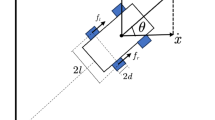Abstract
A number of techniques that allow autonomous multi-robot systems to be held within formation-like structures exist but they are limited by a high communication load, high energy usage and a lack of robustness. This research improves on state-of-the-art formation control schemes for leader-follower type multi-robot systems by employing mechanisms that enable groups of robots to move in two-dimensional formations without the need for inter robot communication. We also incorporate techniques that enable the robots to move back into formation in a precise manner when external interferences have caused the formation shape to deteriorate. The control system is derived through the use of graph theory and has been tested rigorously in a realistic simulator to prove its applicability to multi-robot control.
Access this chapter
Tax calculation will be finalised at checkout
Purchases are for personal use only
Preview
Unable to display preview. Download preview PDF.
Similar content being viewed by others
References
Parker, L.E.: Current Research in multirobot systems. Artif Life Robotics 7, 1–5 (2003)
Chen DS, J., Yang, J., Chen, H.: Leader-Follower Formation Control of Multiple Non-Holonomic Mobile Robots Incorporating a Receding-Horizon Scheme. The International Journal of Robotics Research 29(6), 727–747 (2010)
Florian Durfler, B.F.: Geometric Analysis of the Formation Problem for Autonomous Robots. IEEE Transactions on Automatic Control 55(10), 2379–2384 (2010)
Castro, R., Alvarez, J., Martinez, J.: Robot Formation Control using Backstepping and Sliding Mode Techniques. Paper presented at the Electrical Engineering, Computing Science and Automatic Control, 6th International Conference, Toluca (January 2009)
Barca, C., Sekercioglu, A.: Generating Formations with a Template based Multi-Robot System. In: Australasian Conference on Robotics and Automation, Melbourne, pp. 1–9 (2011)
Yuqing He, J.H.: Multiple Robots Formation Control Based on Receding Horizon Optimization. Paper presented at the IEEE International Conference on Information and Automation, June 22-25 (2009)
Guo, H., Meng, Y., Jin, Y.: Analysis of local communication oad in shape formation of a distributed morphogenetic swarm robotic system. In: IEEE Congress on Evolutionary Computation, Barcelona, pp. 1–8 (2010)
Mamei, M., Vasirani, M., Zambonelli, F.: Experiments of Morphogenesis in Swarms of Simple Mobile Robots. Applied Artificial Intelligence 18(9-10), 903–919 (2004)
Jin, Y., Meng, Y., Guo, H.: A morphogenetic self-organization algorithm for swarm robotic systems using relative position information. Paper Presented at the UK Workshop on Computational Intelligence, Colchester (2010)
Barnes, L., Valavanis, M.K.: Swarm Formation Control Utilizing Elliptical Surfaces and Limiting Functions. IEEE TRansactions on Systems, Man and Cybernetics 39(6), 1434–1445 (2009)
Anderson, B., Yu, C., Fidan, B., Hendrickx, J.: Rigid Graph Control Architectures for Autonomous Formations. IEEE Control Systems Magazine (2008)
Luo, X.-Y., Li, S.-B., Guan, X.-P.: Automatic generation of min-weighted persistent formations. Chinese Physics B 18(8), 3104–3114 (2009)
Author information
Authors and Affiliations
Corresponding author
Editor information
Editors and Affiliations
Rights and permissions
Copyright information
© 2013 Springer-Verlag Berlin Heidelberg
About this paper
Cite this paper
Barca, J.C., Sekercioglu, A., Ford, A. (2013). Controlling Formations of Robots with Graph Theory. In: Lee, S., Cho, H., Yoon, KJ., Lee, J. (eds) Intelligent Autonomous Systems 12. Advances in Intelligent Systems and Computing, vol 194. Springer, Berlin, Heidelberg. https://doi.org/10.1007/978-3-642-33932-5_52
Download citation
DOI: https://doi.org/10.1007/978-3-642-33932-5_52
Publisher Name: Springer, Berlin, Heidelberg
Print ISBN: 978-3-642-33931-8
Online ISBN: 978-3-642-33932-5
eBook Packages: EngineeringEngineering (R0)




